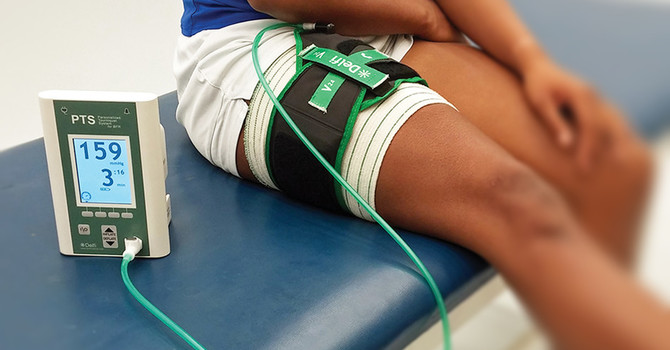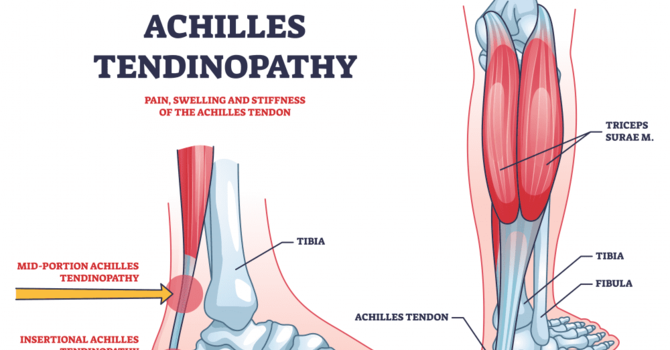
By Austin Baraki via Barbell Medicine
Crepitus is the menacingly-named phenomenon of noises produced by a joint during movement. It is common to hear snaps, crackles, and pops when flexing or extending a knee or an elbow. At times, these noises can be accompanied by a sensation of mechanical stiffness. When combined, these can cause distress, evoking deep-seated fears people have about their bodies “wearing out”. It leads many to seek consultation with a health care provider, even in the absence of pain or functional limitation. The good news is that not only is crepitus very common, it does not necessarily portend dire outcomes, nor should it be something that keeps us from moving, training, and otherwise enjoying an active and fulfilling existence.
History
We’ve been curious about the nature of crepitus for a very long time, with research papers on crepitus dating back as far as the 1800s. Physicians used to perform joint auscultation (i.e., listening to the joint move through a stethoscope), analyzing the volume, frequency, and quality of noise and attempting to correlate it with pathology [1]. As diagnostic methods have become more sophisticated over time, this technique has fallen out of use — and was likely of little real utility anyway.
The traditional assumption is that crepitus always reflects a pathologic process in a joint. It is typically associated with osteoarthritis, which is the most common form of arthritis characterized by joint pain and stiffness. And while it is frequently seen in this situation, a substantial proportion of individuals experience crepitus without clear evidence of osteoarthritis — or sometimes without any other pathology at all. In fact, McCoy et al. investigated 247 symptomatic and 250 normal knees and found that 99% of normal subjects had crepitus at the time of evaluation [2].
Research
It is thought that crepitus can originate from the patellofemoral compartment (i.e., the space between patella and the femur) or from the tibiofemoral compartment (i.e., the space between tibia and femur). We do have some evidence correlating subjective knee crepitus in otherwise asymptomatic individuals with the long-term development of symptomatic tibiofemoral osteoarthritis in the future [3]. However, the development of symptoms and — more importantly — their ultimate effect on the individual is quite nuanced, as we will see shortly. (Editor’s note: Nuanced is a Feigenbaum original. Don’t let Baraki fool you.)
Similarly, de Oliveira Silva et al. performed a cross-sectional study of 165 women with patellofemoral pain and 158 pain-free women [4]. They showed a greater proportion of women in group with knee pain exhibited crepitus compared to the pain-free group (odds ratio = 4.19); however, crepitus showed no relationship with function or other self-reported clinical outcomes. This raises more questions regarding the “objective” significance of crepitus in this situation.
To further examine whether crepitus was associated with objective pathology, Pazzinatto et al. performed two observational studies of 584 and 361 individuals with and without knee crepitus (matched for a measure of radiographic severity known as the Kellgren-Lawrence score) [5]. They found that while individuals with knee crepitus had slightly lower self-reported function and knee-related quality of life, there was no difference in objective knee function or strength between groups. This suggests that the primary difference between groups was more related to individuals’ subjective perception of their knees. These sorts of differences between perceptions of symptoms and objective function have been shown in other contexts as well, including the spine [6].
In this vein, Robertson et al. performed a qualitative study looking at people with crepitus in the context of “patellofemoral pain”, and the impact of these beliefs on their subsequent behavior [7]. Above all, the subjects in the study were most concerned about the meaning of the noise. They often thought it meant they were damaging their joints and that it represented “premature aging” or “degeneration”, which made them feel “old”, anxious, and fearful. This often stems from the inaccurate view of the body as a machine like a car that is similarly prone to “wearing out” with age and activity. The opposite is actually true. Increased activity throughout life can help maintain function, strength, range of motion, and quality of life.
Subjects in the Robertson et al. study also reported feeling embarrassed when the noise was audible in the presence of others, particularly when other people responded negatively to hearing the noise by commenting on it, visibly “wincing”, or voicing concerns like “You should get that checked out“. These are all social mechanisms by which the individual’s perception of danger or damage may increase, and this phenomenon may augment or complicate the pain experience. Consider how you may have influenced others in this way, or how others may have influenced you. This is especially pertinent if you are providing advice from a position of authority, such as a coach or clinician.
Subjects significantly altered their behavior or even stopped certain hobbies, especially when in a quiet environment where the noise is more audible to themselves and others. This is consistent with the established fear-avoidance behavior model [8].
People who knew a family relative with knee problems also tended to assume that their crepitus was likely a manifestation of the same process, reinforcing the cycle of fear and subsequent reduced activity. These sorts of beliefs manifest in statements like “My family has a long history of bad knees”, often paired with the assumption that they will have the same long-term outcomes related to things like pain, disability, or a need for surgery. A coach or clinician working with someone who is concerned about their crepitus might ask whether they know anyone who has similar issues, as this may be influencing their beliefs and feelings about their own knees.
Finally, there was also frequent negative influence from healthcare professionals:
“Most participants had a negative experience of interacting with a health professional with respect to their crepitus, and felt that it was not taken seriously, and was poorly understood as a symptom. This is unsurprising when there is a lack of literature and education on the topic. However, it is well understood from the literature on low back pain that physiotherapists belief systems will in turn impact on patient management, and hence outcome (Daykin, 2004)”
This is a problem we’ve discussed many times before, including in Dr. Ray’s contribution to the first issue of the Barbell Medicine Research review, where he examined an article showing 89% of patients learned their negative beliefs about back pain from healthcare professionals [9]. Another excellent 2018 article focusing on patient’s beliefs about knee osteoarthritis found that they overwhelmingly held beliefs consistent with a traditional pathoanatomical / structurally-focused view of pain, fixated on concepts of “wear and tear”, “bone-on-bone”, and “missing cartilage” [10].
The authors state:
“Despite the sense of certainty around the biomechanical model, participants often had no explanations for the variability of symptoms, the speed of potential degradation, or the best ways to optimise function and slow deterioration. This model of progressive deterioration was in conflict with some participants’ experiences of stable or improving symptoms. Participants appeared not to recognise this discordance … Participants saw ‘wear and tear’ as synonymous with [osteoarthritis] and interpreted the concept literally. Consequently, participants felt that they needed to protect their joint to prevent further wear and tear. These concepts were often reported as originating with, or being reinforced by, health professionals.”
The Takeaway
In other words, the continued fixation on a purely mechanical model of osteoarthritis, which is frequently reinforced by healthcare providers, increases patients’ perception of a need to protect. This promotes inactivity out of fear of worsening the process, despite the ample evidence conflicting with this reductionist model. In fact, inactivity appears to be a greater risk factor for worsening pain and disability due to osteoarthritis — which means that even if crepitus is a possible harbinger of future symptomatic osteoarthritis in some individuals (as might be argued based on the paper by Lo et al. discussed above), it does NOT mean we should avoid training or other physical activity as a result.
Finally, in 2010 Robertson argues in “Joint Crepitus – are we failing our patients?” that [11]:
“It is much more likely that patients with loud, fine crepitus of a non-arthritic origin feel anxious and hypervigilant regarding the meaning of their crepitus, and I think it is this group that often need reassuring …”
Regardless of whether there is arthritis present, our overall approach to the issue of crepitus involves lots of education and reassurance to reframe the individual’s interpretation of the meaning of the symptoms. This is particularly important when there is a substantial amount of fear, avoidance behavior, and mental associations with family members or loved ones who suffered from joint problems.
Successful reframing of these concepts can facilitate healthier behavioral responses and self-management decisions with respect to exercise and physical activity. In some contexts, strategies to reduce attention & hypervigilance to the noise may be useful, such as using ambient noise/music or knee sleeves to “muffle” the noise (but not providing the narrative that such devices are necessary for knee “support”, ”stability”, or “safety”).
As a coach or clinician, it is essential to remain patient and careful with your own language here if you want to make progress with this issue and avoid delivering harmful beliefs to your clients. On the other hand, this power can be used for good to promote confidence, resilience, and self-efficacy in your clients to self-manage and continue to train productively and live a fulfilling life.
Thanks to Derek Miles, DPT, Michael Ray, MS, DC, and Thomas Campitelli, DTFP for their contributions to this article.
Link to origin article source:
https://www.barbellmedicine.com/blog/crepitus-expectations-vs-reality/#:~:text=Crepitus%20is%20the%20menacingly%2Dnamed,a%20sensation%20of%20mechanical%20stiffness.
References
[1] Blodgett WE. Auscultation of the knee joint. Boston Med Surg J 1902; 146: 63-6.
[2] McCoy G, McCrea JD, Beverland D, Kernohan G, Mollan RB. Vibration arthrography as a diagnostic aid in diseases of the knee. J Bone Joint Surg (Br) 1987; 69-B, 2: 288-293
[3] Lo et al. Arthritis Care Res (Hoboken). 2018 January ; 70(1): 53–60.
[4] de Oliveira Silva et al. Phys Ther Sport. 2018 Sep;33:7-11.
[5] Pazzinatto et al. What are the clinical implications of knee crepitus to individuals with knee osteoarthritis? An observational study with data from the Osteoarthritis Initiative. Braz J Phys Ther. 2018 Nov 16. pii: S1413-3555(18)30240-5.
[6] Stanton et al. “Feeling stiffness in the back: a protective perceptual inference in chronic back pain” Scientific reports vol. 7,1 9681. 29 Aug. 2017.
[7] Robertson et al. People’s beliefs about the meaning of crepitus in patellofemoral pain and the impact of these beliefs on their behaviour: A qualitative study. Musculoskelet Sci Pract. 2017 Apr;28:59-64.
[8] Vlaeyen et al. The fear-avoidance model of pain. Pain. 2016 Aug;157(8):1588-9.
[9] Setchell et al. “Individuals’ explanations for their persistent or recurrent low back pain: a cross-sectional survey” BMC musculoskeletal disorders vol. 18,1 466. 17 Nov. 2017.
[10] Darlow et al. Living with osteoarthritis is a balancing act: an exploration of patients’ beliefs about knee pain. BMC Rheumatology 2018. 2:15.
[11] Robertson CJ. Joint crepitus–are we failing our patients? Physiother Res Int. 2010 Dec;15(4):185-8.



